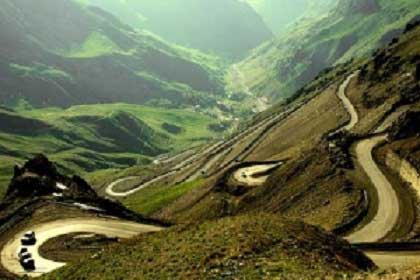The Alborz or Elborz Mountain range is a narrow range that curves all along the southern shore of the Caspian Sea from Azerbaijan province of Iran in North West to Aladak Mountains in north east measuring about 600 mi or 970 km long. This range forms a climatic barrier between the Caspian and the Central part of the Iranian Plateau which results in receiving a good deal of snow and rain in the fertile region of northern side; in stark contrast, the southern side has very few vegetation and is characterized by barren brown slopes and deserts.
The origin of Alborz
The word Alborz is derived from “Hera Barziti”, which is the name of a legendary mountain in Avesta consisting of the word “Barziti” meaning tall, which is still used in Persian today and the prefix “hera” has Indo-European roots and means care and guard. In middle Persian language “Pahlavi”, this name changed to Hara Borz and then to Alborz.
Originally, Alborz Mountains as well as their neighboring range of east, the Kopet Dag, are volcanic and retain the verticality typical of this origin and rise almost as a wall from the southern shores of the Caspian Sea. This range is among the highest in the continent and includes Iran’s highest peak, Damavand (18,934 ft or 5,671 m). Alburz is always important in Persian mythology as a remote base of mythical heroes and gods.
Tehran is located in The south face of Mount Damavand . Other highest peaks of Alborz Mountains are Alamkuh and Takht-i-Suleiman, both above 4,500 m, Khalno 437 and Tochal 3970m, The average Alborz height is 9,000 ft (2,730 m).
Several rivers originate from Alborz mountain range and specially from the central Alborz, The main one that passes through one of these valleys into the Caspian Sea is Kizil Uzen, which joins with the river Shah Rud and then cuts a gap through the western end of the range known as the Sefid Rud in the few kilometers before it reaches the sea. There are some smaller seasonal rivers that drain off the southern slopes of the Alborz range and disappear in Iran’s northern Salt Desert. One of the most significant Iranian port on the Caspian sea, Bandar Anzali, is located on the foothills of the Alborz, known as the center of the Iranian Caviar industry. The port is so close to the larger city of Rasht, which is the terminus of rail and oil lines. At the other end of this range, the city of Bandar Turkman lies near the frontier with Turkmenistan and has always been a trade and communications entrepot between the Middle East and Central Asia, the Silk Road.
Mount Damavand
Located in the central part of Alborz mountain range, Mt Damavand (5610m) is the most prominent natural feature of Iran looming majestically near the southern coast of the Caspian Sea. In terms of national divisions, the peak is located in Larijan county of Amol city, Mazandaran province. It can be seen from the cities of Tehran, Varamin, Qom, as well as the Caspian Sea coast when the sky is clear and sunny. Damavand is a dormant volcano with an iced-caped summit crater (400 m in diameter) that erupted 38,500 years ago – which may happen again.
It is the highest peak of Iran and Middle East and the highest if you travel from Europe eastward to Iran.
The National Iranian Earth Science Database has mentioned a height of 5,670 meters for the mountain which makes Damavand the twelfth highest peak of the world in terms of relative height.
Mount Damavand was registered as the first natural monument of Iran on July 20, 2008. It is worth mentioning that this mountain was considered as a national natural monument in 2002 among four valuable areas in terms of environmental protection. Damavand can be easily reached via Haraz Road from Tehran.
Mt Damavand is visible far from 250km in a clear sky. Just below its crater there are few famous glaciers such as “Yakhar”and “Sioleh”. There are some hot springs on its lower slopes in Larijan county. Because of its great height, the view from top is very extensive, a big panorama of mountains and valley covering some hundreds of square Kilometers. All around are other peaks of the Alborz Mountain Range, in the north to the Caspian Sea plain and in the south descending to the deserts of central Iran. Read More About Damavand >>
Flora and fauna of Alborz
The southern slopes of the Alborz Mountains are usually semiarid or arid, but the northern slopes of the range are usually humid and very fertile, especially in Gilan province located in the western parts of the Central Alborz. The higher elevations of southern part such as Damvand have very few trees including Juniper which is the most common tree in the highest parts, other common plants of the region are pistachio, maple, and almond.in the fertile area of the northern slopes, the Caspian Hyrcanian forests lush eco-region is the most important phenomenon. The natural plants in this region grow in distinct zones, The wild cypress as well as the olive trees grow in the western valleys of the Central Alborz near Sefidrud river.
The most important animals and birds of Alborz are bezoar ibex, Blandford’s fox, Rappel’s fox, red fox, Persian fallow deer, wild boar, Syrian brown bear, Persian leopard, Indian wolf, buzzard, goose, woodpecker, griffon vulture, and eagle . The extinct Caspian Tiger lived around the Caspian Sea through Central Asia to northern Afghanistan and Xinjiang in western China.
Ski resorts
Due to the great snowy, there are several ski resorts in different parts of the central range of Alborz. Some of them such as Dizin, Shemshak, Tochal, abali and Darbandsar are among the best in the whole world.




Comment (0)